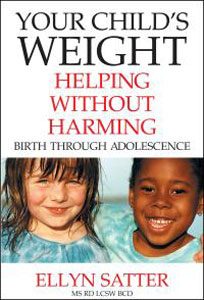

Family Meals Focus
The Ellyn Satter Institute Newsletter
Should you control portion sizes?
Portion size studies don’t apply to real life. Big or little portions, or high-calorie or low-calorie food, can trick you into eating more or less at a given meal or even in a given day. However, over the long term, your body knows how much it needs to eat.
Based on extrapolation from short-term observational research, controlling caloric density and portion sizes has become a primary focus of overweight intervention. Adults seem to stop eating on fewer calories when they are offered lower-calorie food.1 Adults eat more when offered large portion sizes.2 However, the studies do not apply to real life because they examined food regulation patterns for short times: a day, a week, or six meals in a row. For adults, food regulation is easy to trick in the short term, but in the long term, even adults compensate for eating less one time by eating more another.
Studies don’t capture how children really eat
With children, the flaws in logic are failure to interpret research findings in light of feeding dynamics and child development. In short-term studies, some preschoolers eat more when they are offered large portion sizes,3, 4 but toddlers do not.3 The difference is developmental, and the child’s history with feeding. Unless or until grown-ups teach them to clean their plates, preschoolers regulate very well,even with large portion sizes. A preschooler ‘s eating can be distorted because he will do your bidding when you say, ”clean your plate.” He wants to please and can be shamed into doing what you want. A toddler won’t. She is so committed to being her own person that she would rather fight than do your bidding with her eating.
Children know how much to eat
Put serving dishes on the table and let children help themselves. They love doing it, and engaging their independence and initiative around food is all to the good.
In a classical study, children demonstrated that, without interference, they regulate very well. Preschoolers who were given either a high-calorie pudding or low-calorie pudding 20 minutes before a meal compensated with their lunch intake. Those who ate the high-calorie pudding ate fewer little sandwiches. Those who ate the low-calorie pudding ate more little sandwiches.5 Some of the children did not compensate; they ate the same number of lunch-time sandwiches no matter which pudding they ate before. The difference was in the eating and feeding behaviors of the parents. Parents who were controlling of their own and their children’s food intake raised children whose ability to self-regulate was impaired.3
Do your jobs with feeding and let children do their jobs with eating
What to do instead of controlling portion sizes? To help parents develop realistic expectations of how much children eat, give general guidelines: a tablespoon per year of age, a quarter of a piece for a toddler, half for a preschooler, etc. Such guidelines are less likely to be misinterpreted as hard-and-fast rules. Better still, recommend putting serving dishes on the table and letting children help themselves. They love doing it, and engaging their independence and initiative around food is all to the good. Rather than getting specific about amounts and types of food that children should eat, emphasize family meals, and maintain the division of responsibility in feeding: adults do the what, when, and where of feeding and children do the how much and whether of eating.
Adults know how much to eat
Adults who have lost the ability to regulate food intake can get it back by maintaining a grownup division of responsibility in feeding: Feed yourself faithfully, and give yourself permission to eat.
References
- Bell EA, Rolls BJ. Energy density of foods affects energy intake across multiple levels of fat content in lean and obese women. American Journal of Clinical Nutrition. 2001;73:1010-1018.
- Rolls BJ, Roe L, Meengs J, Wall D. Increasing the portion size of a sandwich increases energy intake. Journal of the American Dietetic Association. 2004;104:367-372.
- Rolls BJ, Engell D, Birch LL. Serving portion size influences 5-year-old but not 3-year-old children’s food intakes. Journal of the American Dietetic Association. 2000;100:232-234.
- Mrdjenovic G, Levitsky DA. Children eat what they are served: the imprecise regulation of energy intake. Appetite. 2005;44(Computer):273-282.
- Birch LL, McPhee LS, Bryant JL, Johnson SL. Children’s lunch intake: Effects of midmorning snacks varying in energy density and fat content. Appetite. 1993;20:83-94.
Explore
Understand and Apply ecSatter
For help with raising your big child or your small child to feel good about himself and have the body that is right for him, read Ellyn Satter's Your Child’s Weight: Helping Without Harming

